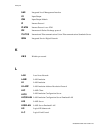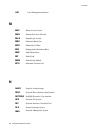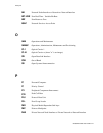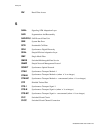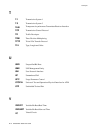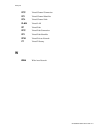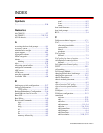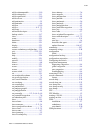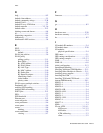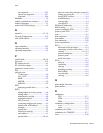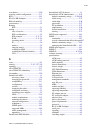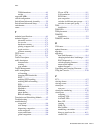SmartSwitch 6500 User Guide Index-5
Index
not supported .................................... B-7
objects not supported........................ B-7
supported .......................................... B-6
MinIndex.................................................. 7-6
module combinations in chassis............. 2-12
module placement .................................... 2-7
multi-level PNNI topology....................... 4-2
N
netprefix ............................................3-3, 3-6
Network Configuration ..........................2-13
node ATM address ...................................4-1
O
object identifier ....................................... B-3
operating humidity .................................. A-2
operating temperature.............................. A-2
P
parallel links......................................4-8, 4-9
password.................................................2-15
PC adapter pin-out................................... A-3
PC serial port adapter.............................. A-3
permanent virtual circuits.........................6-1
PGL ..........................................................4-2
physical ports
75 ohm coax...................................... A-2
Cat. 5 UTP ........................................ A-2
MMF................................................. A-2
SMF-IR............................................. A-2
SMF-LR............................................ A-2
PNN
managing parallel links......................4-8
PNNI
adding higher-level peer groups ........4-6
adding nodes......................................4-4
administrative weight ........................4-8
aggregation tokens.............................4-9
class of service................................... 4-8
connecting multiple peer groups........ 4-2
default node ATM address ................4-1
example..............................................4-2
logical link......................................... 4-5
multi-level topology .......................... 4-2
node address ......................................4-1
parallel links ...............................4-8, 4-9
physical connections and peer groups4-6
setting peer group ID .........................4-3
starting PGL election .........................4-4
troubleshooting ..................................9-3
viewing links......................................4-4
viewing PGL......................................4-5
PNNI node addressing..............................4-1
PNNI routing............................................4-1
point-to-multipoint PVCs.........................6-2
point-to-point PVCs .................................6-1
ponf...........................................................8-2
port congestion.........................................9-5
port number ............................................2-20
port numbering.......................................2-20
power requirements.................................A-1
PVCs.........................................................6-1
backward traffic descriptor................6-3
connecting to local switch client........6-4
creating .......................................6-1, 6-2
point-to-multipoint.............................6-2
point-to-point.....................................6-1
traffic descriptor.................................6-1
PVPs .........................................................6-4
add pvp...............................................6-6
connecting..........................................6-6
creating ..............................................6-6
disabling signaling.............................6-5
MaxVpiBits........................................6-5
set portconfig .....................................6-5
viewing ..............................................6-6
Q
queue buffer allocation.............................7-5
queue buffers............................................7-5
R
redundancy
CPU..................................................2-17
CSM.................................................2-18
TSM .................................................2-17
redundancy configuration.......................2-16
scsm ...................................................8-3
swms ..................................................8-3
redundancy for CSM ................................8-3
redundancy for TSM/CPU .....................2-17
reset ........................................................2-20



